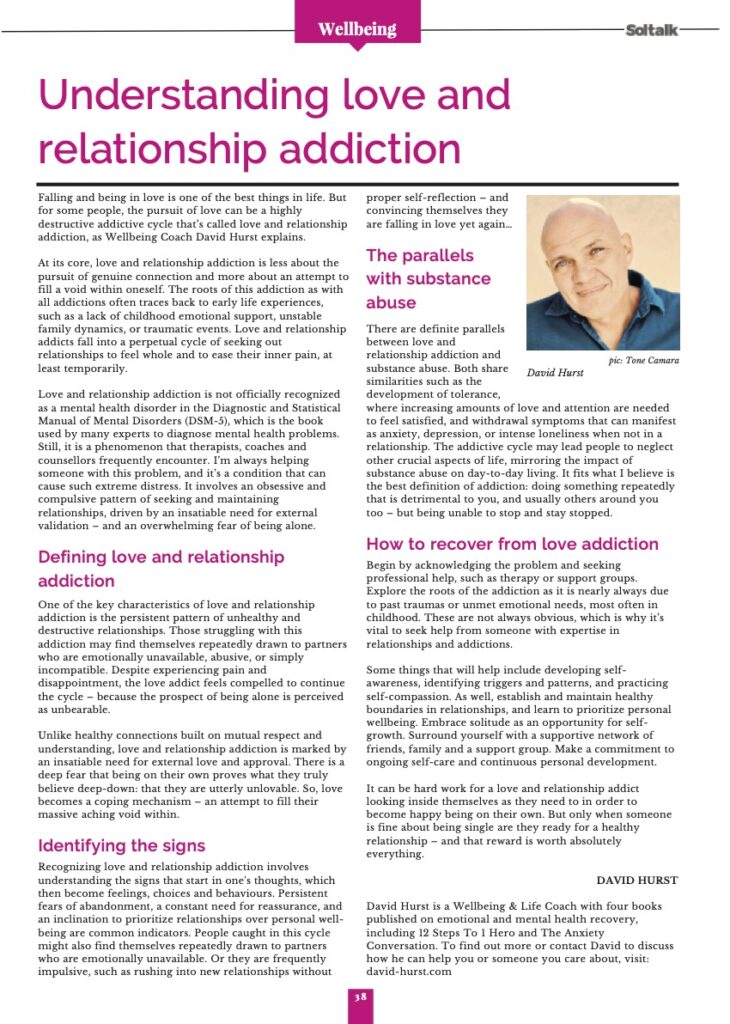Understanding love and relationship addiction

Falling and being in love is one of the best things in life. But for some people, the pursuit of love can be a highly destructive addictive cycle that’s called love and relationship addiction.
At its core, love and relationship addiction is less about the pursuit of genuine connection and more about an attempt to fill a void within oneself. The roots of this addiction as with all addictions often traces back to early life experiences, such as a lack of childhood emotional support, unstable family dynamics, or traumatic events. Love and relationship addicts fall into a perpetual cycle of seeking out relationships to feel whole and to ease their inner pain, at least temporarily.
Love and relationship addiction is not officially recognized as a mental health disorder in the Diagnostic and Statistical Manual of Mental Disorders (DSM-5), which is the book used by many experts to diagnose mental health problems. Still, it is a phenomenon that therapists, coaches and counsellors frequently encounter. I’m always helping someone with this problem, and it’s a condition that can cause such extreme distress. It involves an obsessive and compulsive pattern of seeking and maintaining relationships, driven by an insatiable need for external validation – and an overwhelming fear of being alone.
Defining love and relationship addiction
One of the key characteristics of love and relationship addiction is the persistent pattern of unhealthy and destructive relationships. Those struggling with this addiction may find themselves repeatedly drawn to partners who are emotionally unavailable, abusive, or simply incompatible. Despite experiencing pain and disappointment, the love addict feels compelled to continue the cycle – because the prospect of being alone is perceived as unbearable.
Unlike healthy connections built on mutual respect and understanding, love and relationship addiction is marked by an insatiable need for external love and approval. There is a deep fear that being on their own proves what they truly believe deep-down: that they are utterly unlovable. So, love becomes a coping mechanism – an attempt to fill their massive aching void within.
Identifying the signs
Recognizing love and relationship addiction involves understanding the signs that start in one’s thoughts, which then become feelings, choices and behaviours. Persistent fears of abandonment, a constant need for reassurance, and an inclination to prioritize relationships over personal well-being are common indicators. People caught in this cycle might also find themselves repeatedly drawn to partners who are emotionally unavailable. Or they are frequently impulsive, such as rushing into new relationships without proper self-reflection – and convincing themselves they are falling in love yet again…
The parallels with substance abuse
There are definite parallels between love and relationship addiction and substance abuse. Both share similarities such as the development of tolerance, where increasing amounts of love and attention are needed to feel satisfied, and withdrawal symptoms that can manifest as anxiety, depression, or intense loneliness when not in a relationship. The addictive cycle may lead people to neglect other crucial aspects of life, mirroring the impact of substance abuse on day-to-day living. It fits what I believe is the best definition of addiction: doing something repeatedly that is detrimental to you, and usually others around you too – but being unable to stop and stay stopped.
How to recover from love addiction
Begin by acknowledging the problem and seeking professional help, such as therapy or support groups. Explore the roots of the addiction as it is nearly always due to past traumas or unmet emotional needs, most often in childhood. These are not always obvious, which is why it’s vital to seek help from someone with expertise in relationships and addictions.
Some things that will help include developing self-awareness, identifying triggers and patterns, and practicing self-compassion. As well, establish and maintain healthy boundaries in relationships, and learn to prioritize personal wellbeing. Embrace solitude as an opportunity for self-growth. Surround yourself with a supportive network of friends, family and a support group. Make a commitment to ongoing self-care and continuous personal development.
It can be hard work for a love and relationship addict looking inside themselves as they need to in order to become happy being on their own. But only when someone is fine about being single are they ready for a healthy relationship – and that reward is worth absolutely everything.

My latest article for Soltalk magazine.
